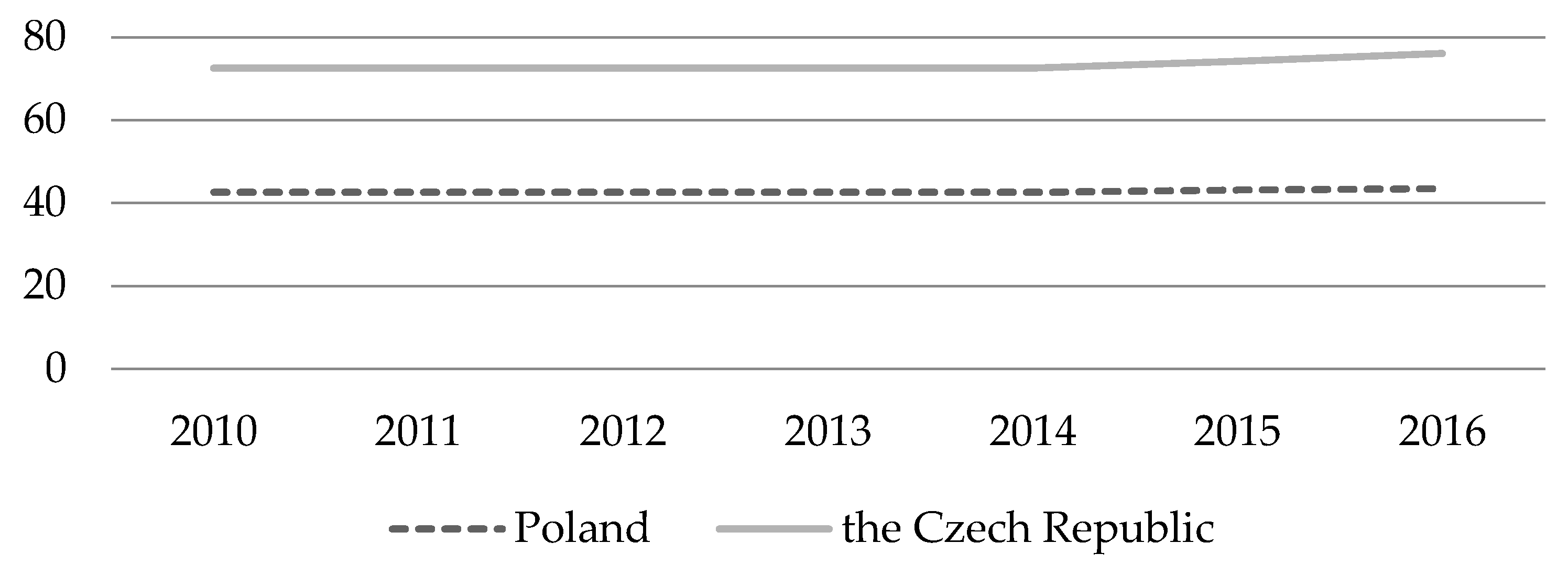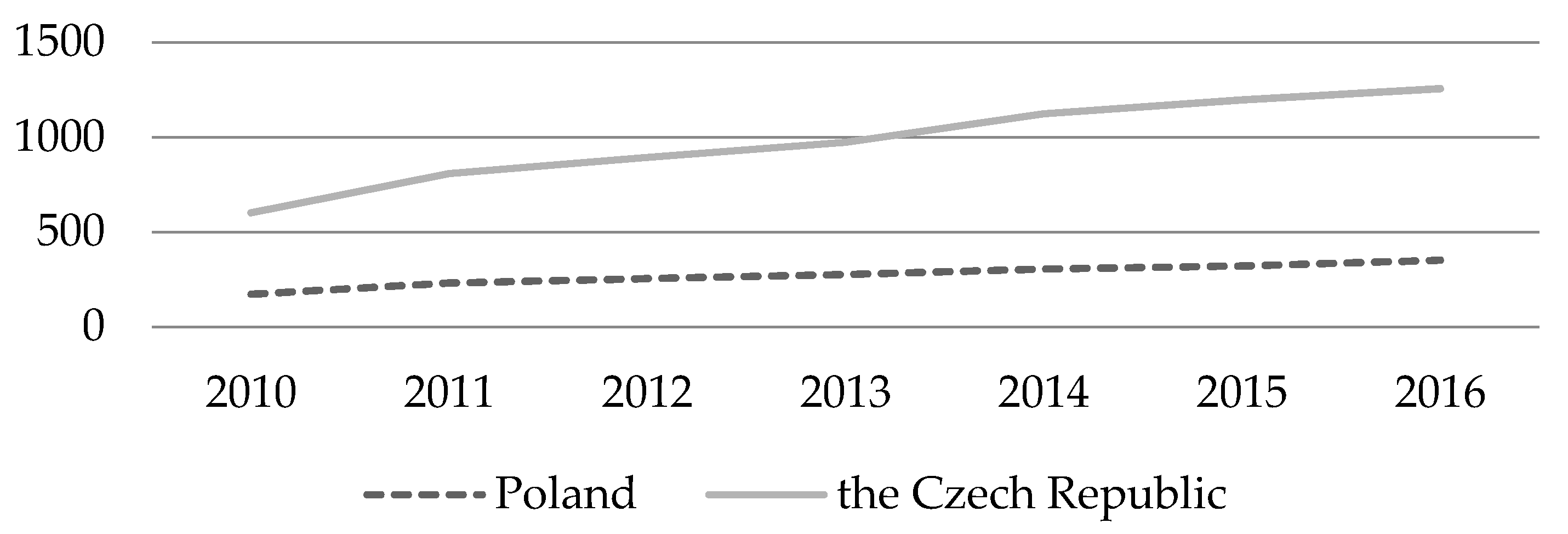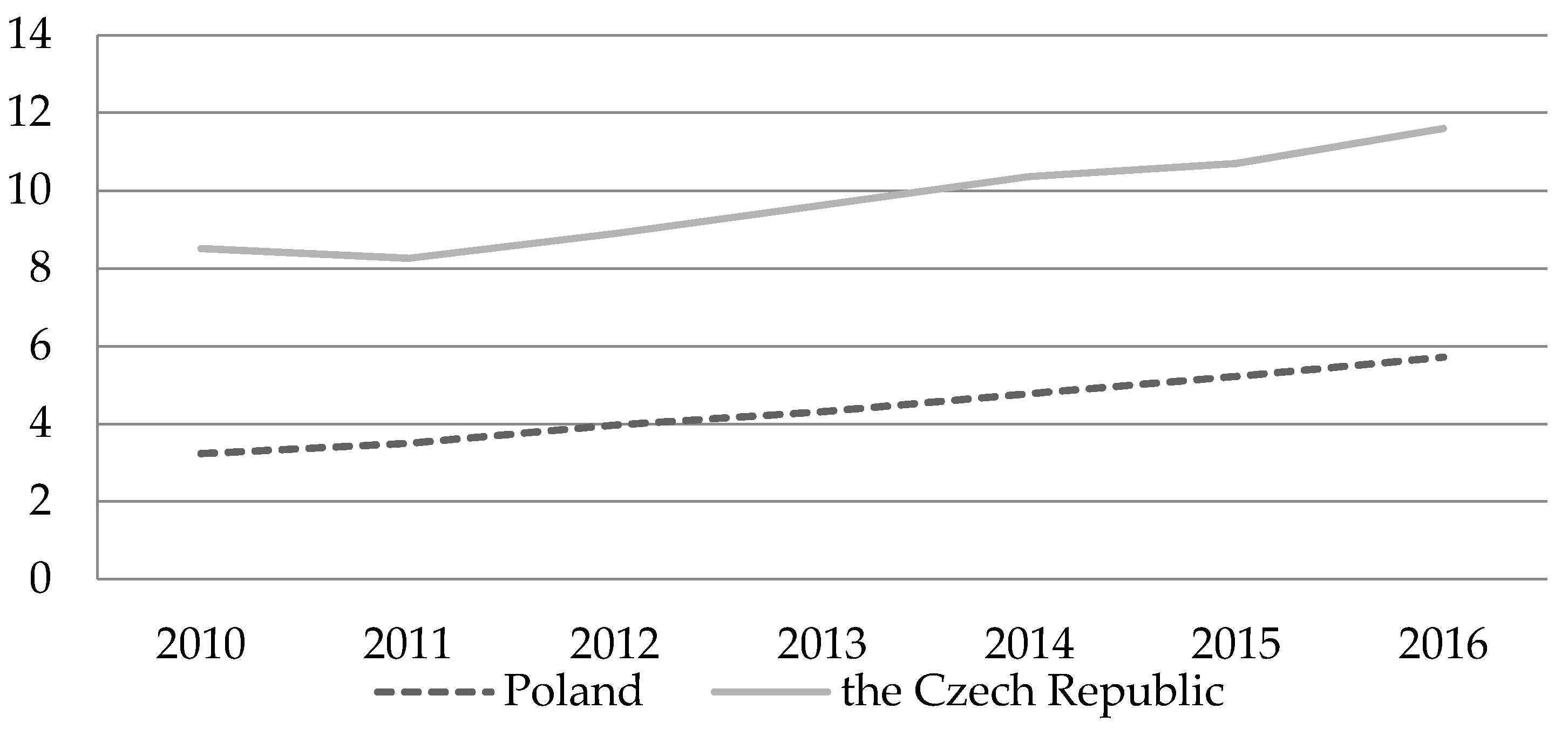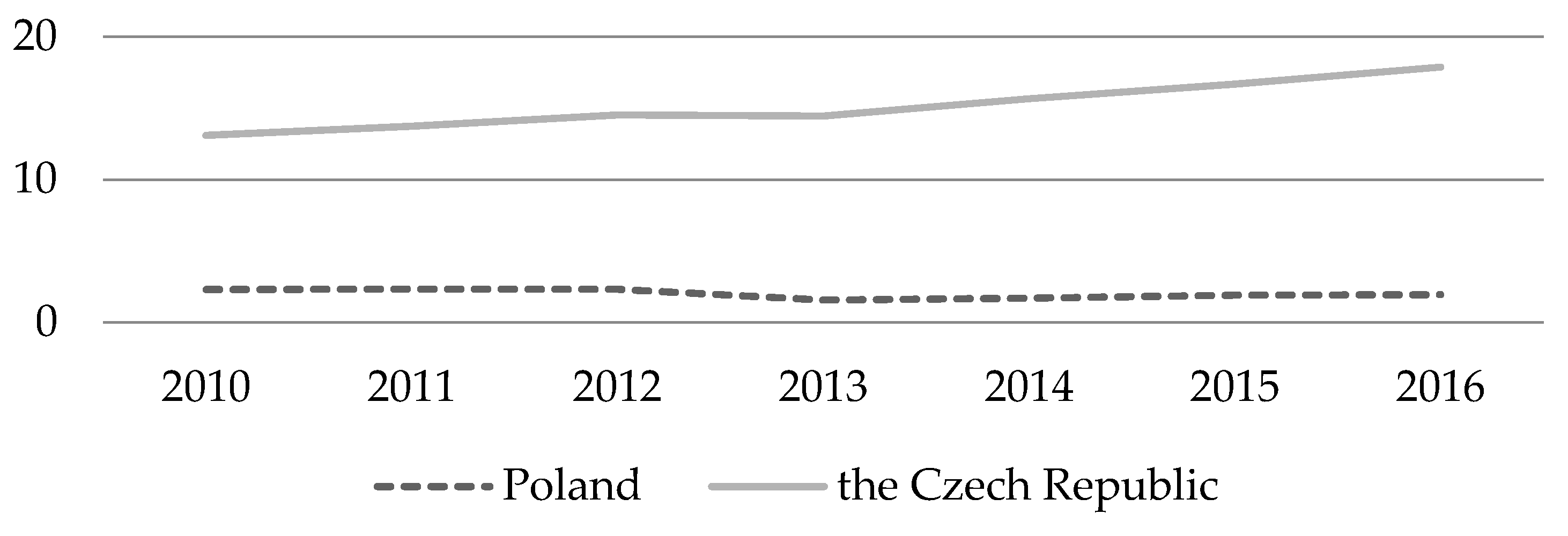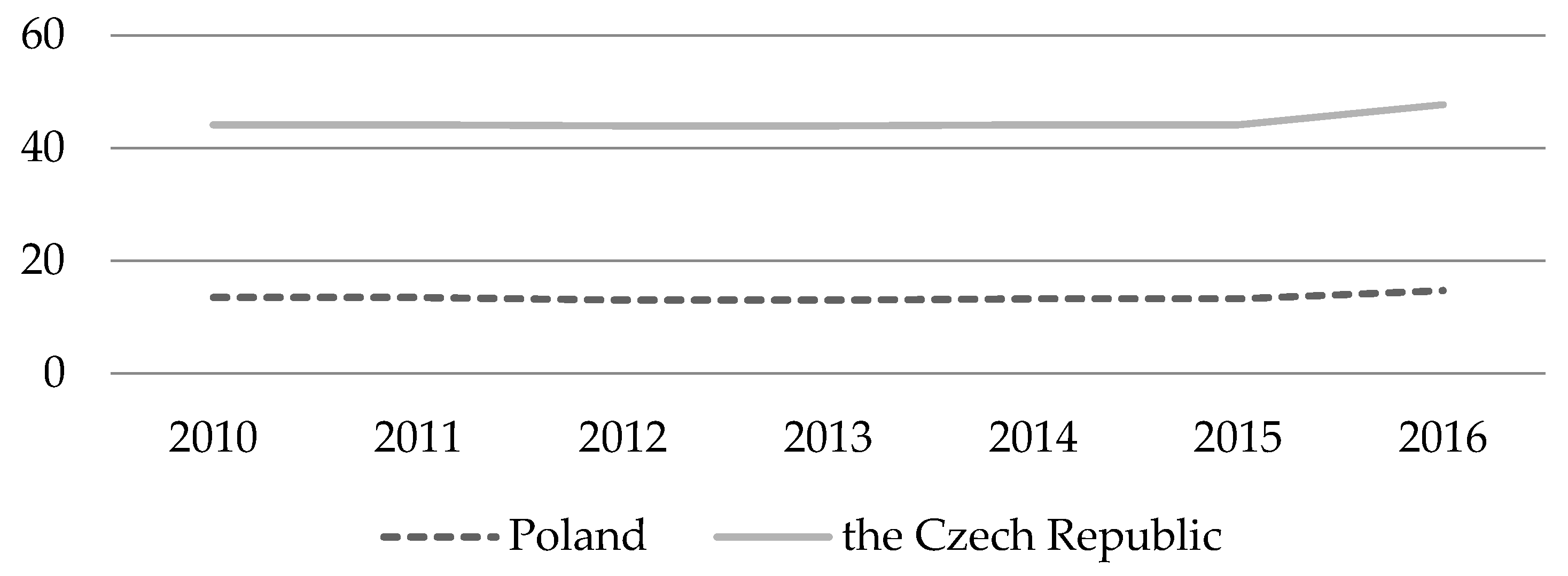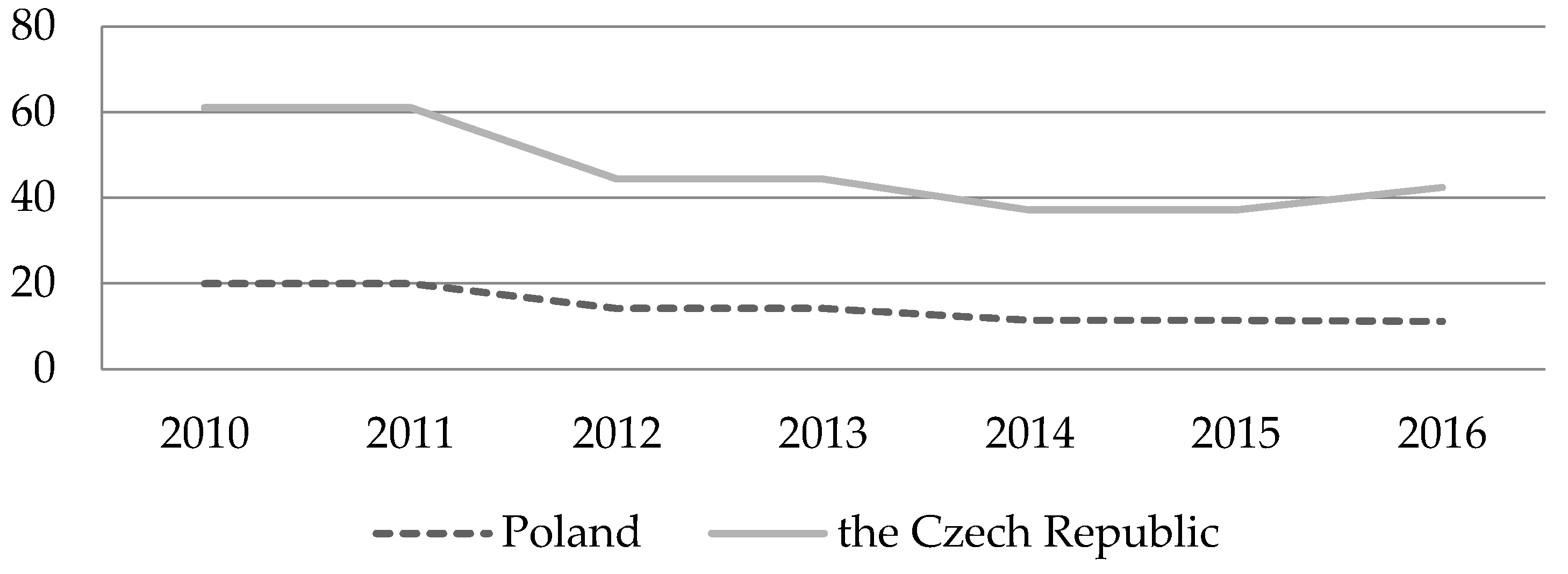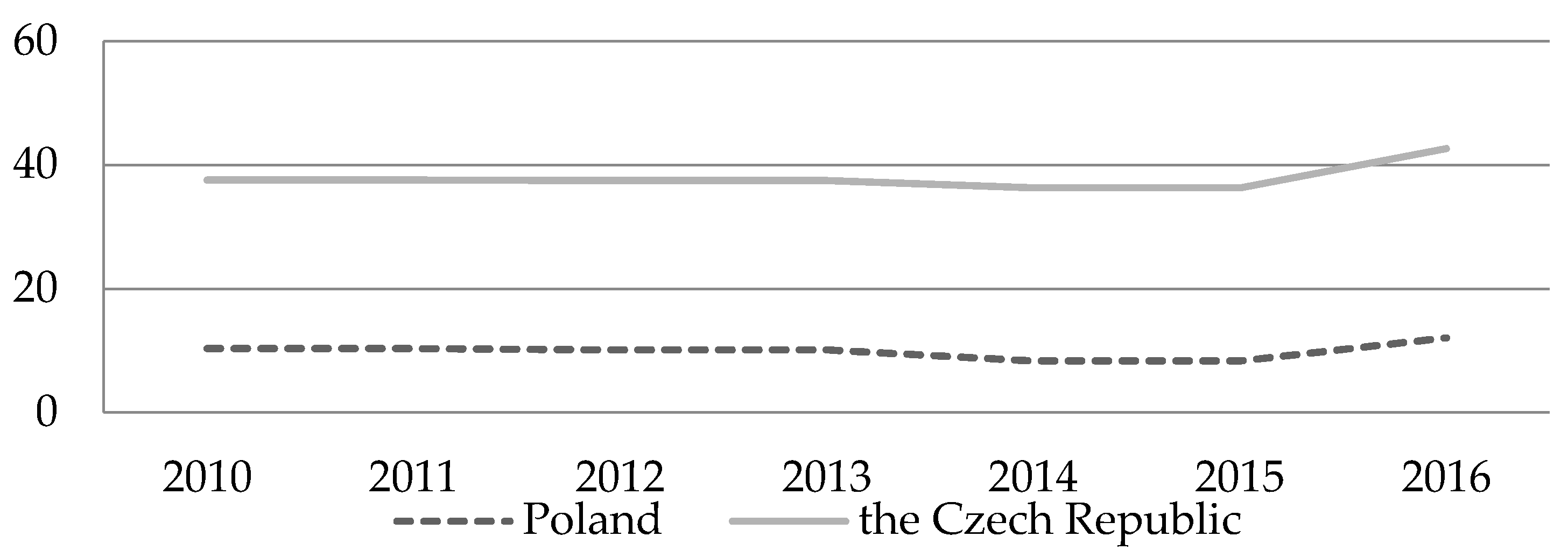1. Introduction
It has been widely argued that innovation stimulates competitive advantage of firms, regions, and countries [
1,
2] and contributes to sustainable development [
3]. This implies the importance of actions enhancing innovation. The value of innovation has been recognised by the European Union, which, in the Europe 2020 Strategy, emphasises substantial concern about the creation of conditions for sustainable and inclusive growth [
4,
5]. Particularly, major focus is given to interaction between firms’ innovation and the economic growth of regions and countries [
6]. In this context, the rank of innovation activities of firms seems crucial because of their significant contribution to the enhancing competitiveness of regions and countries [
7]. The determinants of firm innovation are the subject of extensive theoretical and empirical studies [
8]. A growing body of literature deals with the role of knowledge diffusion in firms’ innovation performance [
9,
10]. Such processes foster innovations and increase competitive advantage. These issues are particularly considered in endogenous growth and knowledge spillover theories. In this regard, the current state of the literature largely supports the view of human resources as being important in knowledge diffusion and in fostering firms’ innovation performance [
11,
12], with high-skilled workers believed to constitute a crucial factor for building competitive advantage of firms [
10]. It is also believed that the research system plays a significant role in knowledge diffusion processes [
6]. Specifically, it has been observed that the research system reflects the competitiveness of the science and capacity for involvement in firms’ innovation performance by providing knowledge [
13,
14]. Human resources and the research system, being essential for innovation performance of firms, are of special interest to European Union firms [
4]. However, for all that, the debate on the determinants of firms’ innovation performance is still incomplete, particularly with regards to human resources and the research system.
This paper seeks to add to the existing knowledge by investigating the importance of human resources and the research system for firms’ innovation activities. These relationships were tested for Poland and the Czech Republic. Focusing on these countries may provide an interesting setting since innovation performance in Poland and the Czech Republic is similar and below the European Union’s average [
4]. Hence, it seems important to investigate what enhances firms’ innovation performance in these countries and consequently, increases their competitive advantage. However, despite growing literature on firms’ innovation performance [
15,
16,
17], little attention has been devoted so far to the significance of human resources and the research system for innovation activities of Polish and Czech firms.
To address this important gap, this study aims to test whether human resources and the research system affect Polish and Czech firms’ innovation activities. The data used in the study were sourced from the European Innovation Scoreboard (2018, 2019). The Cobb–Douglas function was used to test the hypotheses. The research period was 2010–2016.
This study adds evidence to the literature on the relevance of human resources and the research system in pursuing innovation activities in Polish and Czech firms. It also contributes to the existing studies by employing the Cobb–Douglas function to investigate the extent to which human resources and the research system matter in firms’ innovation activities.
The remainder of the paper is structured as follows: The first section provides theoretical background and hypothesis development. The second section presents the methodology employed to identify the importance of human resources and the research system for Polish and Czech firms’ innovation activities. The third section introduces the results, comprising a comparative analysis of the variables employed for the study. This section also sheds light on the effect of human resources and the research system on innovation activities of firms from Poland and the Czech Republic. The fourth section discusses the results. In the final section, conclusions are provided together with policy and practical implications of the study, limitations and suggestions for further research.
2. Literature Review
Over the past years, a vast body of literature has argued that the interaction between firms, regions, and countries is a key to sustainable development [
12]. The existing evidence suggests that innovation activities of firms are crucial for the sustainable development of regions and countries [
10]. A number of theoretical and empirical studies deal with determinants of innovation performance [
6,
18,
19]. Most of them point to the importance of both endogenous and exogenous determinants in enhancing competitiveness of firms, regions, and countries [
20,
21,
22,
23,
24,
25,
26]. Particularly, a considerable amount of research has been devoted to investigating how Research and Development (R&D) expenditures might have an impact on firms’ innovation activities [
16,
17]. It has been suggested that public and private expenditure on R&D can shift firms’ competitive advantage [
15].
In the most recent studies, a great attention has been devoted to recognising the role of knowledge diffusion in improving innovation performance [
1,
27]. These studies point out that the network among firms, universities, research organisations and institutional environments is essential to build competitive advantages of firms, regions and countries [
18]. As noted by Broekel and Boschma, “firms’ embeddedness in knowledge networks is crucial for their economic success” [
28] (p. 3) and firms tend to acquire knowledge from various sources [
14]. A number of studies highlight human resources [
13,
29,
30] and the research system [
31,
32] as playing a pivotal role for firms’ innovation performance. This set of studies argues that human resources (regarded, among others, as the knowledge or skills of workers) have a high potential for enhancing competitive advantage not only of firms, but also of regions and countries [
10,
29]. These studies also emphasise the research system as knowledge infrastructures that may affect knowledge creation and knowledge difussion [
27].
The existing evidence suggests that high-skilled workers are more likely to increase firms’ innovation performance [
11,
33]. This indicates that tertiary education, second-stage tertiary education, and lifelong learning might matter for firms and their innovation activities [
4]. Particularly, second-stage tertiary education is regarded as a substantial determinant of innovation, with its considerable leverage on knowledge creation and competitive advantage enhancement [
5,
34]. For example, it has been observed that doctoral graduates are “an important source of skilled and innovative knowledge workers” [
35] (p. 60) because of their contribution to knowledge diffusion.
Another part of the literature is focused on identifying the relevance of tertiary education for firms’ innovation performance [
4]. A wide body of empirical literature assesses the role of a population with a bachelor’s degree and above as a source of workers with advanced skills [
36,
37]. In this sense, the European Union emphasises the population, especially aged 25–34, having completed tertiary education as the group reflecting relatively quick changes in educational policy and in labour market needs [
5].
A growing body of work also investigates lifelong learning as relevant for firms’ innovation performance [
4]. As noted by Mitchell and MacFarlane, lifelong learning means “learning that continues throughout one’s life” [
38] (p. 67) and contributes to improving worker knowledge and skills [
12,
39]. Following this idea, lifelong learning contributes to innovation performance of firms as a significant stock of knowledge.
There are strong arguments for regarding the research system as fundamental for knowledge diffusion among firms, universities and research organisations, which is likely to affect firms’ innovation activities [
6,
27,
40,
41]. It has been observed that the research system plays a crucial role in external knowledge creation [
13,
14]. Following this, the existing literature shows the relevance of international scientific co-publications, the top 10% most cited publications, and foreign doctorate students for innovation performance of firms [
5].
The existing evidence suggests that international scientific co-publications are indicative of science productivity [
42]. As noted by Hoekman, Frenken, and Tijssen, such science collaboration “generates intellectual benefits through the cross-fertilisation of ideas” [
43] and contributes to knowledge diffusion [
44]. This may affect the enhancement of competitive advantage of firms, regions, and countries.
Other studies point to highly cited publications as being an important part of knowledge creation [
45] and a measure of the efficiency of the research system. Here, the top 10% most cited publications are essential [
5]. Leydesdorff, Wagner, and Bornmann argue that such publications “represent the scientific elite” [
46] (p. 607). From this point of view, the top 10% most cited publications contribute to the diffusion of high-quality knowledge among universities, research organisations and firms. Accordingly, there are strong reasons for assuming that such publications may affect innovation activities of firms.
Another line of literature indicates foreign doctorate students as an important part of knowledge diffusion processes [
4,
47]. In line with this argument, firms, through a network with the research system, may acquire high-quality external knowledge. This may contribute to enhancing firms’ innovation activities and, consequently, to improving the economic growth of regions, countries, and to sustainable development.
Hence, while a considerable amount of research has been devoted to investigating the role of human resources and the research system in firms’ innovation activities, very few studies have analysed this topic in regard to Polish and Czech firms. Therefore, it is significant to carry out research in respect to Poland and the Czech Republic and investigate how human resources and the research system affect innovation activities of firms in countries with similar innovation performance and remaining below the European Union’s average. Thus, the hypotheses to be tested are the following:
Hypothesis 1 (H1). Human resources positively affect firms’ innovation activities.
Hypothesis 2 (H2). The research system has a positive effect on innovation activities of firms.
3. Materials and Methods
This study is based on data sourced from the European Innovation Scoreboard (2018, 2019) for Poland (PL) and the Czech Republic (CZ). The European Innovation Scoreboard covers data related to innovation performance of the European Union Member States from such sources as (among others) Eurostat and Scopus, and puts special emphasis on the significance of small and medium-sized enterprises (SMEs) in achieving competitive advantage of regions and countries. Using data from the European Innovation Scoreboard allows a comparative analysis between Poland and the Czech Republic in terms of the effect of human resources and the research system on firms’ innovation activities. The research period was 2010–2016. The research is divided into two parts. The first part contains a comparative analysis of human resources and the research system (explanatory variables), and innovation performance of firms (dependent variables) between Poland and the Czech Republic. The second part focuses on how human resources and the research system affect innovation activities of Polish and Czech firms, with the usage of the Cobb–Douglas function.
Due to various measurements of human resources, the research system, and innovation activities of firms, the study follows the European Innovation Scoreboard approach, where variables used in the study have been embodied by a set of indicators.
The description of these variables is found in
Table 1.
Table 2 shows the summary statistics of variables.
To detect the presence of a high level of collinearity between explanatory variables, the graph analysis method [
48] was used.
To investigate whether human resources and the research system affect Polish and Czech firms’ innovation activities, the Cobb–Douglas function was used. This function is distinguished by simplicity and good matching to empirical data [
49]. First, six models were estimated (three for Poland and three for the Czech Republic) on the basis of the Cobb–Douglas function [
50]:
where
b0,
b1, …,
bk are constants.
Such a number of models corresponds to various measurements of firms’ innovation activities and results from the diversity of innovation performance [
51]. Next, the generated models were log-transformed according to the formula:
where
b0,
b1, …, and
bk are constants.
Least-squares regression was applied to verify the statistical significance of the models. The Breusch–Godfrey test was employed to control for the autocorrelation.
5. Discussion
The study provides insights into the effect of human resources and the research system on innovation activities of firms from Poland and the Czech Republic. Both in terms of human resources and the research system, the results of comparative analysis show a higher potential for the Czech Republic than Poland in 2010–2016. This suggests that firms from the Czech Republic are in much better shape than those from Poland when it comes to the ability to acquire high-skilled workers and external knowledge from universities and research organisations. This might result in a better basis to enhance innovation activities and, consequently, a greater increase in competitive advantage of regions and for the country than Poland.
The results of the Cobb–Douglas function estimation partially confirm the research hypotheses. Regarding Poland, the results find that innovation activities of Polish firms (measured as the percentage of SMEs introducing marketing or organisational innovations) were positively affected by only one variable related to human resources—lifelong learning. These findings are consistent with Hypothesis 1 and are similar to studies by [
4,
12,
38], among others. To enhance innovation performance, the results suggest a need for intensifying the networks between Polish firms and the population aged 25–64 that is participating in lifelong learning. Contrary to expectations, the research system does not seem to have been related with Polish firms’ innovation activities in 2010–2016. These findings do not uphold Hypothesis 2 and are contrary to, among others, [
5,
46]. These results imply a need for strengthening networks between the research system and firms in Poland for the diffusion of high-quality knowledge as the basis for increasing Polish firms’ innovation activities.
As regards the Czech Republic, the results suggest a significant effect of such a variable of the research system as the top 10% most cited publications on firms’ innovation activities in 2010–2016. However, it is remarkable that the research suggests diverse results. A positive effect of the top 10% most cited publications is related to innovation activities of firms described as the percentage of SMEs introducing product or process innovations and the percentage of SMEs innovating in-house. These results, confirmed with Hypothesis 2, are in line with [
27]. On the other hand, the results show a negative effect of the top 10% most cited publications in association with firms’ innovation activities, measured as the percentage of SMEs introducing marketing or organisational innovations. These results do not confirm Hypothesis 2 and are contrary to, among others, [
47]. Such results may imply limited abilities of firms from the Czech Republic to acquire high-quality knowledge from the research system. The above findings may arise from the diversity of firms’ innovation performance. It should be noted that a high level of collinearity between explanatory variables and the need to eliminate selected variables resulted in an inability to test the effect of variables related with human resources on Czech firms’ innovation activities. These also precluded the possibility to compare the results of the Cobb–Douglas function estimation between Poland and the Czech Republic. Further, in-depth studies are required to resolve this issue.
6. Conclusions
This paper contributes to the discussion of variables of firms’ innovation activities. The research was focused on Poland and the Czech Republic as the countries with similar innovation performance and remaining below the European Union’s average. This research complements previous studies by shedding light on the effect of variables related to human resources and the research system on Polish and Czech firms’ innovation activities.
The implication of the Cobb–Douglas function allows the identification of a positive effect of lifelong learning on Polish firms’ innovation activities in 2010–2016, supporting the idea that constant learning is the key to improving the knowledge and skills of workers and to enhancing firms’ innovation activities. The study also shows a significant and diverse effect of the top 10% most cited publications on Czech firms’ innovation activities. Such differentiation may stem from the diversity of firms’ innovation performance. The results highlight the need to strengthen the diffusion of high-quality knowledge among universities, research organisations, and firms.
This paper has practical and policy implications. As the study points the role of human resources and the research system in firms’ innovation activities, it is relevant to provide conditions for the development of human resources and the research system to enhance firms’ competitive advantage and sustainable growth of regions and countries. There is also a need to strengthen knowledge diffusion processes among firms, universities, and research organisations in order to improve innovation activities of firms.
This study faces limitations that may be examined in future research. First, this paper draws on data and measurement of variables from the European Innovation Scoreboard. It is important to observe whether the obtained results also hold for other descriptions of innovation activities of firms and other measurements of human resources and the research system. Second, future research should investigate the causes of the differential effect of variables employed for the study on Polish and Czech firms’ innovation activities. It would be also beneficial to carry out research using other econometrical methods.
